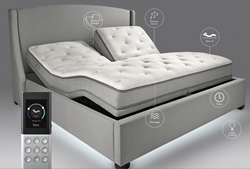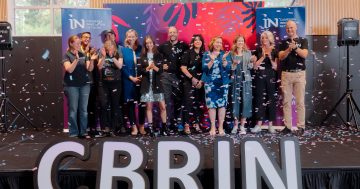Geoffrey A. Fowler* says that from rocking beds to pillows that nudge you when you snore, there’s a range of sleep tech flooding the market — but does any of it work?
 Much of it is promising to some degree — the question is what’s worth it.
Much of it is promising to some degree — the question is what’s worth it.
Seema Khosla, who runs the tech committee of the American Academy of Sleep Medicine, tries sleep gadgets herself and understands the appeal of data.
But she doesn’t like how some use proprietary algorithms doctors can’t access or understand.
“We embrace technology and think it is great, but we are asking that it be validated,” she says.
Just knowing you spent $5,000 on a bed also might keep some up.
The doctors I spoke with recommend not buying anything until you’ve taken their free advice: Go to bed and wake up at the same time every day.
We sleep better in cooler rooms and ones with as little light as possible.
And the biggest sleep distraction may be your smartphone, so leave it just in earshot outside the bedroom.
Where might sleep tech help you?
Here are four areas where the tech is making strides — and some advice from the doctors on where to be cautious.
- Measuring sleep
Plenty of people think they get eight hours — until they start measuring.
Recording sleep lets you experiment to figure out what helps.
Sleep Number (pictured) embeds sensors throughout its mattresses, which measure each side of the bed for movement as well as heart rate and respiration.
The smart bed has been a moderate improvement over my dumb bed, though its makers say it takes weeks to really kick in.
But it left me a bit restless at first, perhaps because I laid in bed ruminating about turning my sleep into data.
(There’s already a term — orthosomnia — for becoming so obsessed with quantifying sleep that you actually lose sleep.)
A wireless tracker called Beddr SleepTuner measures even more.
Pop the postage-stamp-size sensor on your forehead (via a medical-grade sticker), and in addition to recording your head’s movement, it reads the oxygen in your blood and tries to identify when you stop breathing.
That can help you understand why you might be waking up unrested — also an indicator you should see a doctor about sleep apnoea.
And there’s a free app called SleepScore that tracks sleep stages using sonar, listening for waves bouncing off your body to identify when you’re in light, deep and REM sleep.
One big downside: You have to leave your phone close to your bed.
The doctors with whom I spoke have concerns about the accuracy of these measures — particularly for sleep quality — and warn that none can either identify or clear you of a disorder.
The other challenge is turning all that data into action.
- Stopping snoring
The inventor of a foolproof way to stop snoring will become a billionaire.
Until then, there are a few intriguing gadgets — if you can stand bringing them to bed with you.
Bose makes $250 noise-masking headphones called Sleepbuds to help the long-suffering bed partners of people who snore.
For the snoring perpetrator, there are several aggressive connected pillows.
The Smart Nora and the 10Minds Smart Motion Pillow use microphones to listen for snoring and activate pumps or motors to shift your head to positions where you’re less likely to snore — all without waking you up.
When I tried the 10Minds version, it felt as if someone was assertively but lovingly shoving my head to the side.
Another device, the Hupnos, is an eye and nose mask that listens for snoring.
It first tries to get you to turn your head by subtly vibrating.
But if you keep snoring, it’ll send air pressure through your nose to ensure your airway remains open.
The red flag: snoring can be associated with sleep apnoea, a serious condition where you aren’t getting enough oxygen.
Using one of these devices may cover up the real problem, so it’s worth seeing a doctor.
- Making you comfy
The biggest target for sleep tech is the bedroom environment: temperature, light, sound and the mattress where you spend a remarkable amount of time.
Think of these gadgets like upgrading to business class — you’re paying to be more comfortable, which might just leave you feeling better on the other side.
A few stand out for their creativity.
Aromarest, a diffuser, lamp and white-noise machine, lulls you with lavender and wakes you with citrus.
Building on evidence that we fall asleep better in cooler places, the Ooler is a water-chilled mattress topper, and Moona is a $300 pillow that does the same for just the head.
And then there’s the Rocking Bed.
It sways you to sleep, inspired by how a hammock synchronises brain waves during a nap.
It was comfy, but after 10 minutes it felt as though the room was moving without me.
The problem with much of this stuff is you won’t know what works until you sleep with it.
“Make sure you know the refund policy before you buy,” Harvard’s Khosla says.
- Adjusting your mind
The most overlooked element of good sleep is a calm mind, especially in a world of smartphones and Netflix binges.
Meditation apps such as Headspace can help you disconnect from the day, but doctors warn using your phone before bed might be counterproductive, since you’re staring into light that tells the brain to be alert.
If meditation isn’t for you, perhaps a robot can help.
A device called Somnox chills you out by simulating the breathing of a bed companion.
Sensors detect your breath, and try to regulate it subconsciously when you hug the cloth-covered robot and feel the rising and falling of its “breathing” and hear its soothing sounds.
It’s a high-tech teddy.
There’s also a growing niche of brainwave-reading devices, such as the Dreem — a lightweight cap that tracks your brain activity, heart, respiration and movement.
You can use the data as feedback for breathing and relaxation exercises.
And Dreem also touts the ability to emit “sound stimulations” while you’re in deep sleep, improving its quality.
Not surprisingly, the doctors with whom I spoke were most sceptical about brain gadgets, though they hadn’t reviewed them personally.
“Don’t believe any device that says it will give you the restorative effect of eight hours of sleep in four,” says Rafael Pelayo of the Stanford Sleep Medicine Centre.
Tech might help you get more out of sleep, but you can’t get away with not sleeping.
* Geoffrey A. Fowler is The Washington Post’s technology columnist based in San Francisco. He tweets at @geoffreyfowler.
This article first appeared at www.washingtonpost.com.





